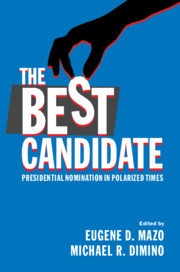Book contents
- The Best Candidate
- The Best Candidate
- Copyright page
- Dedication
- Contents
- Contributors
- Introduction
- 1 Presidential Selection: Historical, Institutional, and Democratic Perspectives
- 2 The Historical Development of the U.S. Presidential Nomination Process
- 3 Constitutional Law and the Presidential Nomination Process
- 4 Winnowing and Endorsing: Separating the Two Distinct Functions of Party Primaries
- 5 Simplifying Presidential Primaries
- 6 The Case for Standardizing Primary Voter Eligibility Rules
- 7 Primary Day: Why Presidential Nominees Should Be Chosen on a Single Day
- 8 A Eulogy for Caucuses
- 9 Floor Fight: Protecting the National Party Conventions from Manipulation
- 10 A Better Financing System? The Death and Possible Rebirth of the Presidential Nomination Public Financing Program
- 11 Campaign Finance Deregulation and the Hyperpolarization of Presidential Nominations in the Super PAC Era
- 12 Democratizing the Presidential Debates
- 13 The Influence of Technology on Presidential Primary Campaigns
- 14 Women and the Presidency
- 15 The Nomination of Presidential Candidates by Minor Political Parties
- 16 Reforming the Presidential Nominating Process: A Curmudgeon’s View
- Index
12 - Democratizing the Presidential Debates
Published online by Cambridge University Press: 10 September 2020
- The Best Candidate
- The Best Candidate
- Copyright page
- Dedication
- Contents
- Contributors
- Introduction
- 1 Presidential Selection: Historical, Institutional, and Democratic Perspectives
- 2 The Historical Development of the U.S. Presidential Nomination Process
- 3 Constitutional Law and the Presidential Nomination Process
- 4 Winnowing and Endorsing: Separating the Two Distinct Functions of Party Primaries
- 5 Simplifying Presidential Primaries
- 6 The Case for Standardizing Primary Voter Eligibility Rules
- 7 Primary Day: Why Presidential Nominees Should Be Chosen on a Single Day
- 8 A Eulogy for Caucuses
- 9 Floor Fight: Protecting the National Party Conventions from Manipulation
- 10 A Better Financing System? The Death and Possible Rebirth of the Presidential Nomination Public Financing Program
- 11 Campaign Finance Deregulation and the Hyperpolarization of Presidential Nominations in the Super PAC Era
- 12 Democratizing the Presidential Debates
- 13 The Influence of Technology on Presidential Primary Campaigns
- 14 Women and the Presidency
- 15 The Nomination of Presidential Candidates by Minor Political Parties
- 16 Reforming the Presidential Nominating Process: A Curmudgeon’s View
- Index
Summary
When it comes to electing the chief executive of the United States, the presidential debates play an important role in shaping public opinion and the choices facing voters. Having a fair process in place to determine who is eligible to participate in the debates and to guarantee that the debates are conducted neutrally is crucial to ensuring the integrity of the electoral process as a whole. In the past, controversies have arisen concerning which candidates should be invited to participate, which political parties should be represented, and whether the debates have been conducted in a way that is fair and neutral. Most of these controversies have never been resolved satisfactorily. Today, much more work needs to be done to ensure that our presidential primary and general election debates live up to their potential to provide truly diverse policy views to the public and are conducted in a manner that is wholly free from bias. Gender bias in terms of the questions asked of the candidates was evident in 2016, and other kinds of biases may appear in the future. Problematically, the eligibility rules for the general presidential debates have remained unchanged for decades. Meanwhile, government oversight of the debates remains virtually non-existent.
Keywords
- Type
- Chapter
- Information
- The Best CandidatePresidential Nomination in Polarized Times, pp. 279 - 308Publisher: Cambridge University PressPrint publication year: 2020

